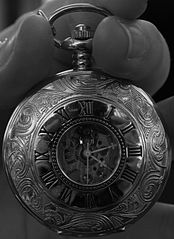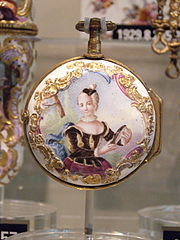Pocket watches are something that have had a long and very varied history. As the saying goes “Tempus Fugit”, time flees. These items can be simply designed and functional, meant for every day use, or they can be intricate and ornate objects which are meant to be shown as a display of wealth, as well as serving a useful purpose. Timepieces are now amongst the most collectable items of jewelry for sale at auction these days and over the coming months there are two important and notable events doing just that.
Intricately designed pocket watch from the 18th century. Image courtesy of wikimediacommons
Thousands of years ago, man had literally no concept of time. Life was governed by the transition of the seasons and day moving into night. The notion of AM or PM just did not figure at all. Over the centuries, the need to be more concise and recognize how the day evolved became more necessary. The first recorded instance of pocket watches came during the later stages of the middle ages when people from the upper classes of society requested craftsmen to make them timepieces that they could hand around their necks, primarily as a show of wealth but also as a stylish means of being able to tell the time accurately wherever they were.
It was alleged that Queen Elizabeth I of England was one of the first people to own a wrist watch and other notable names in history who are said to have owned pocket watches are the Duke of Modena and the Ottoman watchmaker Meshur Sheyh Dede.
Until the Industrial Revolution they really were the reserve of the upper echelons of society only. The ordinary person would simply have to carry on relying on whether the sun was over the yardarm or not! Once the Industrial Revolution took hold, the trend for these pieces spread worldwide as trade broadened and important developments like the railways cropped up everywhere. In the United States and The United Kingdom it was made compulsory for men who worked on the railways to have about their person at all times an accurate method of telling the time, thus they were supplied with pocket watches to be able to do this. They only fell out of favour when technology moved on with the development of the Quartz movement which rendered the daily winding of watches obsolete.
Pocket watch Auctions
 Ornately engraved pocket watch with roman numerals. Image courtesy of wikimediacommons
Ornately engraved pocket watch with roman numerals. Image courtesy of wikimediacommons
An article in the New York Times from last week tells of a number of different auctions that are coming up, purely devoted to the selling of pocket watches, many of which have their own story to tell or secrets to yield. A majority of the pieces from the first auction, which starts this coming weekend on the 29th and 30th September in New Hampshire, come from one anonymous person’s collection. There will be a large number of pocket watches to be sold here, with auctioneers estimating that many of them will sell for thousands of dollars each as they come with original instructions and boxes.
Many of the time pieces have been lovingly engraved with people’s names or carry the names of people who had spent many years working as part of the fire service or on the newly developing railway systems, which gives them an added historical importance and may mean they are relevant to anyone who knows they had an ancestor that worked on the railways during this period.
The two day auction will on day one take in watches that came from Europe, whilst the second day’s sale will feature US timepieces as well as carriage clocks and chronometers from ships.
A second auction takes place in Philadelphia at the start of November, which is a smaller collection, mainly consisting of European watches that have come from different benefactors who have donated pieces to the Museum of Art there. The collection isn’t expected to fetch as much as the New Hampshire auction will, but there is just as much interest in the pieces for sale.
Keeping time
 image courtesy of wikimediacommons
image courtesy of wikimediacommons
It’s important to make sure that if you’re planning on going to these auctions or on buying a precious timepiece, such as a pocket watch or antique clock that you make sure to protect from theft at all times and get the right insurance policy so that it is safe within your home environment.
Time pieces such as these are very often created from precious metals that are ornately engraved or come in intricately designed boxes that add to their value. Therefore caring for them and storing them properly is paramount if they are to keep their value and stay safe once they’re out of the auction room.
It’s important to make sure that if you’re planning on going to these auctions or on buying a precious timepiece, such as a pocket watch or antique clock that you make sure to protect from theft at all times and get the right insurance policy so that it is safe within your home environment.
